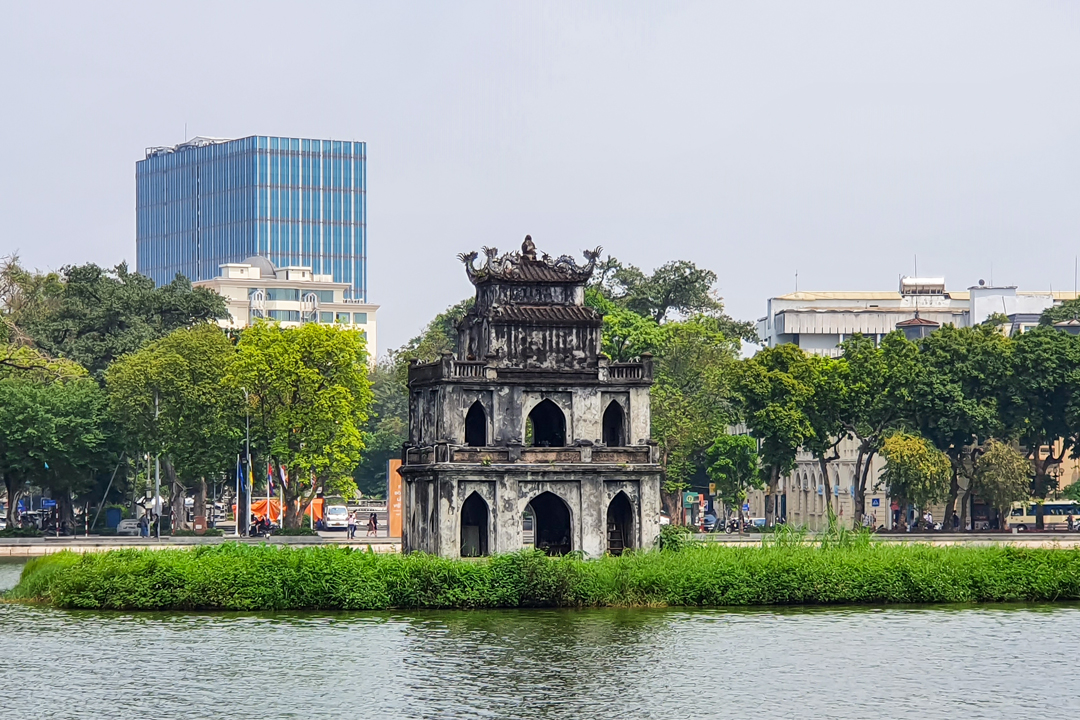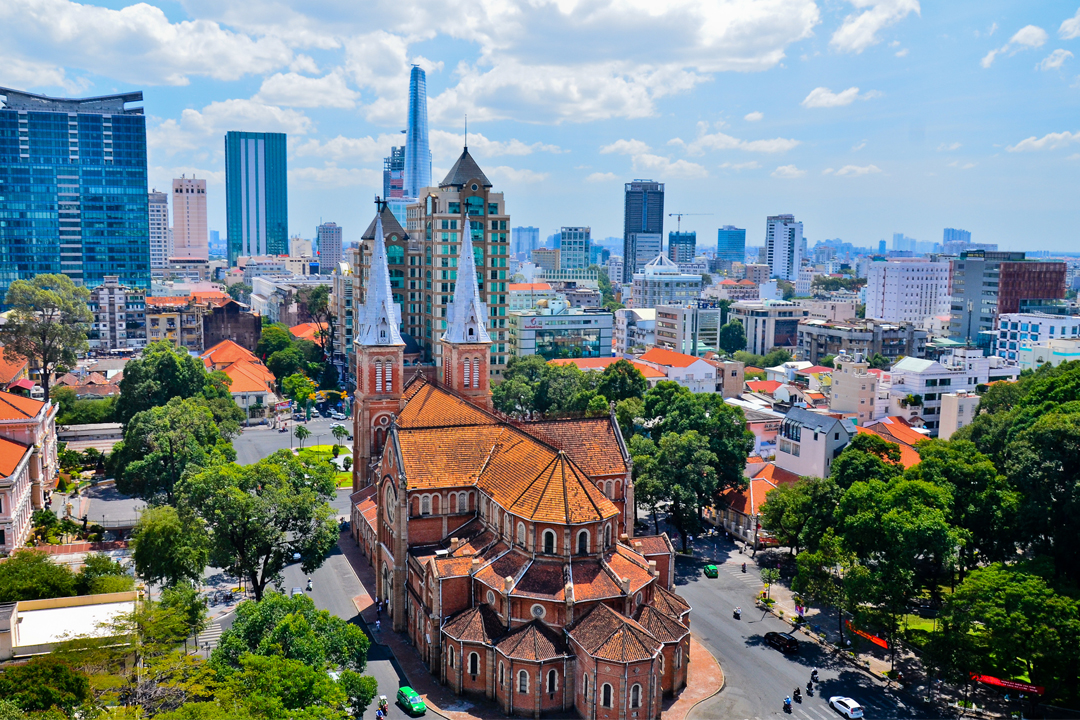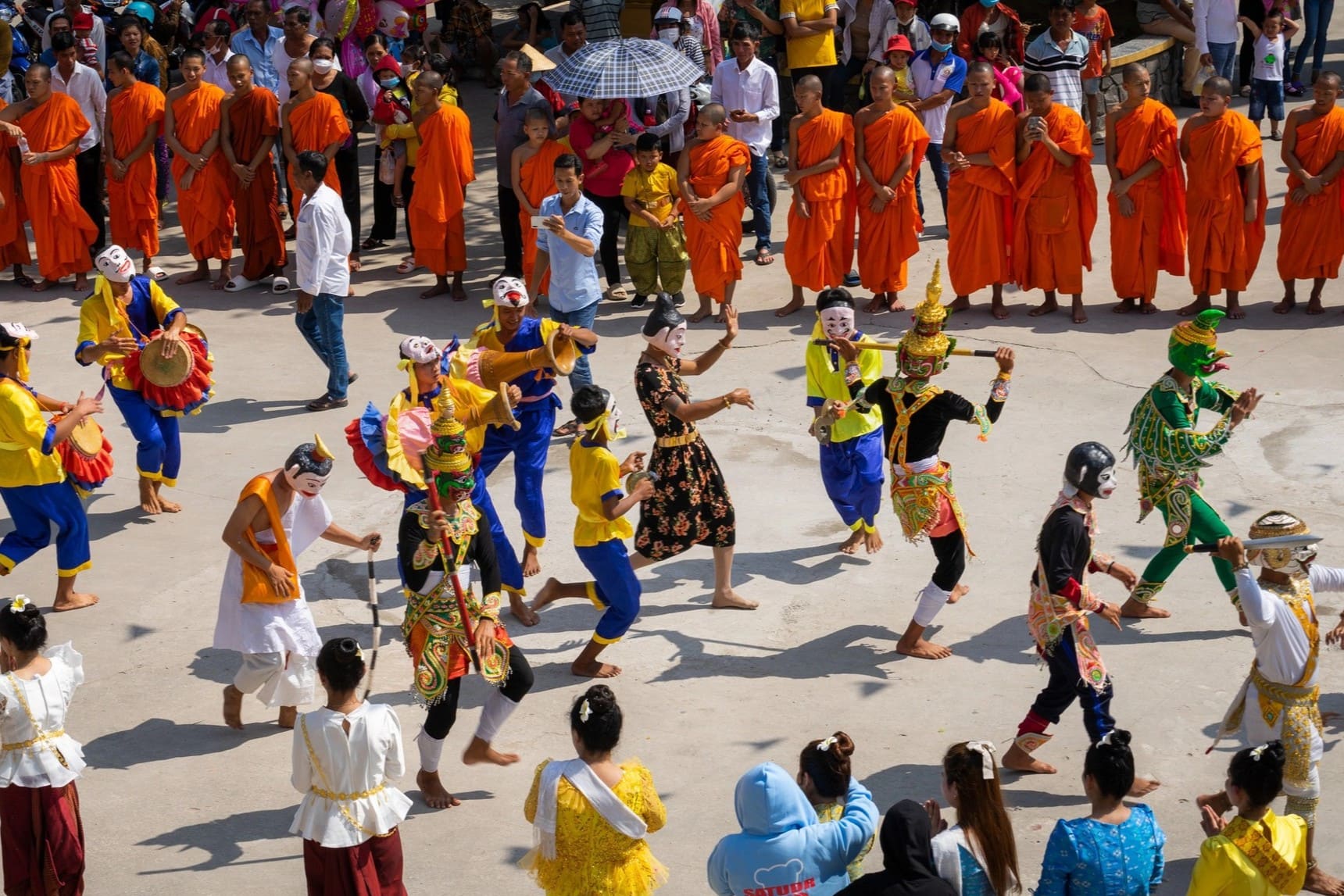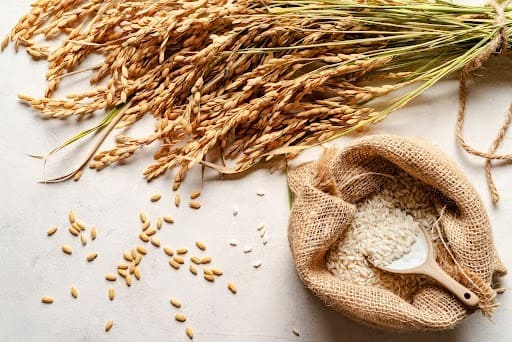Perfume River: History, Architecture, Things To Do & Travel Guide
Flowing gracefully through Hue, the Perfume River stands as a symbol of Vietnam’s rich heritage and natural splendor. This iconic waterway, also known as Huong River, is steeped in centuries of history and culture, with ancient legends that reveal the origins of its poetic name. Along its tranquil banks stands Thien Mu Pagoda, a revered spiritual landmark with intricate pagoda design that captures the essence of traditional Vietnamese architecture.
Beyond its historical allure, Perfume River offers a wealth of activities that connect visitors with both nature and local life. You can take a dragon boat ride to SUP, the river offers unforgettable ways to experience Hue’s beauty. As you drift along, Hue folklore songs and festive boat races bring the region’s culture to life.
In this article, you’ll discover the fascinating history of the Perfume River, the majestic architecture of Thien Mu Pagoda, and the best things to do along the Perfume River. We’ll also guide you through seasonal highlights, practical tips on how to get to Perfume River, and must-see attractions near the river.
History of Perfume River
Perfume River carries deep historical and cultural significance in Hue. Flowing through the heart of the ancient capital, the river has long been intertwined with the city’s heritage, influencing both daily life and spiritual practices. Its name is rooted in local legends and natural phenomena, contributing to its iconic status in Vietnamese folklore.
One prominent legend explains that centuries ago, the river carried the fragrant aroma of blooming flowers from upstream orchards, earning the name Perfume River. Another tale speaks of celestial beings descending to bathe in its waters, infusing the river with a delicate scent. These stories reflect the river’s role in shaping Hue’s cultural identity, as its gentle flow has inspired poets, artists, and musicians throughout history.
Beyond folklore, the river has played a crucial role in Hue’s development. During the Nguyen Dynasty, which established Hue as Vietnam’s imperial capital, the river served as a key transportation route. Royal boats travelled its waters, carrying emperors and court officials to landmarks like Tu Duc Tomb and Khai Dinh Tomb, both located near its banks. This connection reinforced the river’s association with Vietnam’s royal heritage, making it a symbol of both natural beauty and political power.
The river also played a strategic role during historical conflicts, including the resistance against French colonial forces. Its winding course and surrounding terrain provided natural defences, while local communities relied on its resources for sustenance and trade. Over time, the river’s presence has become inseparable from Hue’s identity, symbolizing resilience, cultural continuity, and spiritual harmony.
When you explore the river today can still witness these historical influences. Traditional dragon boats adorned with vibrant colors glide along the water, reminiscent of royal vessels from the past. As the sun sets over Perfume River, its waters reflect the golden hues of twilight, creating a scene that captures both the beauty and history of Hue. This ancient landscape blends with riverside landmarks like Thien Mu Pagoda, a symbol of Hue’s spiritual heritage.
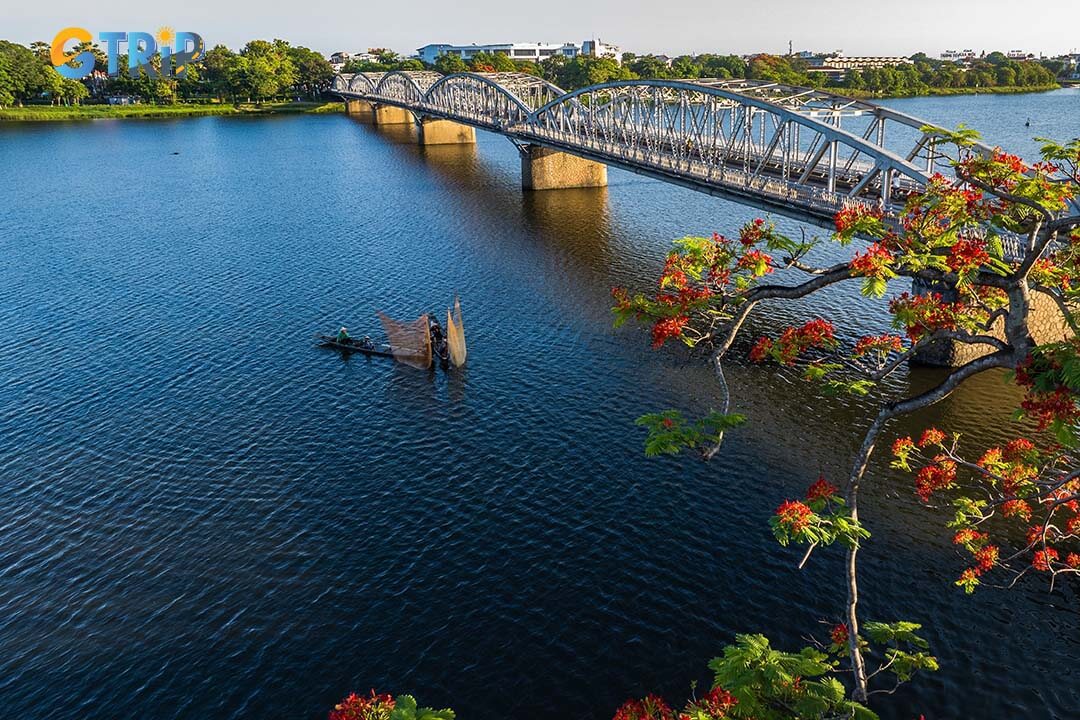
Perfume River is a historic and cultural symbol, famed for its legends, royal connections, and natural beauty
5 things to do along Perfume River
The Perfume River winds through Hue, shaping its landscapes, culture, and daily life. You can take boat rides and SUP adventures to mesmerizing traditional music performances, the river offers countless ways to explore the city's beauty.
1. Enjoy a Perfume River boat tour
A Perfume River boat tour is a serene way to take in Hue’s landscapes and cultural heritage. Traditional dragon boats, decorated with intricate motifs, glide along the calm waters, offering scenic views of temples and lush greenery. Along the riverbanks, fishermen cast their nets while locals gather by the shore, adding to the picturesque setting.
As evening approaches, a sunset cruise becomes an unforgettable experience. The fading sunlight paints the water in golden hues, creating a stunning backdrop for photography. Many tours feature live performances of Hue folklore songs, where traditional melodies harmonize with the gentle ripples of the river. As the sun sets behind Ngu Binh Mountain, the sky transforms into vibrant shades of orange, pink, and purple, making for breathtaking views.
2. Experience Perfume River SUP paddling adventure
SUP on the Perfume River is an exciting way to explore Hue’s natural beauty and cultural heritage. Unlike larger boats, SUP paddlers can navigate hidden corners of the river, offering a closer look at untouched landscapes. The journey often begins near Truong Tien Bridge, where the bustling city gradually fades into peaceful countryside scenery.
As paddlers glide beneath moss-covered stone bridges, the riverbanks reveal daily life in motion fishermen casting nets, farmers tending rice fields, and birds like herons and kingfishers perched along the shore. Early morning and late afternoon offer stunning photography opportunities, with golden light reflecting off pagodas and garden houses.
For a deeper cultural experience, guided tours often include visits to riverside villages, where you can learn traditional crafts like conical hat making and incense production. Passing by the iconic Thien Mu Pagoda, with its towering presence above the treetops, adds a spiritual touch to the adventure.

SUP on the Perfume River offers a unique blend of adventure, nature, and culture, allowing paddlers to explore hidden corners
3. Enjoy traditional music in a dragon boat
A Perfume River cruise becomes even more captivating with the melodies of traditional Vietnamese music drifting across the water. One of Hue’s most immersive cultural experiences is enjoying a live performance of Nha Nhac, the royal court music of the Nguyen Dynasty.
As the dragon boat glides along, musicians in elegant ao dai perform on ancient instruments, each adding unique tones to the ensemble. The dan bau, a monochord zither, creates hauntingly expressive notes, while the dan nguyet, a two-stringed moon lute, enriches the harmony. Other instruments like the dan tranh (16-string zither) and bamboo flutes further enhance the performance.
The repertoire blends imperial compositions with folk songs celebrating love, nature, and daily life, evoking a deep connection to Vietnam’s past. As the melodies intertwine with the gentle ripples of the river, the experience offers a serene yet vibrant glimpse into Hue’s artistic heritage.
4. Capture scenic photography along the Perfume River
Perfume River is a dynamic canvas of natural beauty and cultural landmarks. Its still waters reflect the landscape, offering stunning shots. Morning mist adds a dreamlike touch as golden sunlight emerges. This tranquil glow is perfect for capturing silhouettes of fishermen casting nets or wooden boats gliding downstream.
As the day unfolds, the riverbanks come alive with vibrant local life. During warmer months, clusters of lotus flowers bloom along the edges, their pink and white petals contrasting with the emerald-green water. Riverside trees frame landscapes, while Trang Tien Bridge adds striking symmetry, especially at sunrise and sunset.
Thien Mu Pagoda, with its iconic seven-tiered tower rising above the treetops, serves as a compelling focal point. On still days, its reflection in the river enhances composition depth. Further downstream, glimpses of the Imperial City through the foliage add historical charm to wide-angle shots.
As night falls, Hue’s city lights shimmer on the water, transforming the river into a glowing tapestry. Trang Tien Bridge lights up with shifting colors, offering dramatic long-exposure photography opportunities. Meanwhile, lantern-lit boats drift silently, their warm glow adding a sense of cultural tradition to the evening scene.
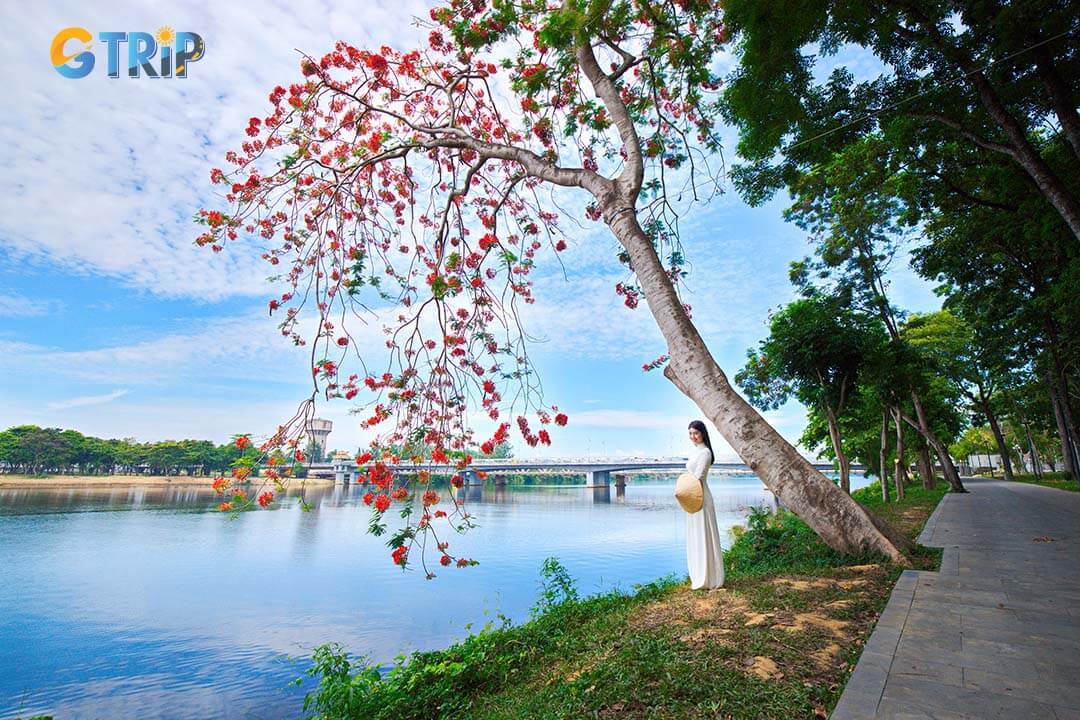
Perfume River offers an ever-changing canvas of natural beauty, cultural landmarks, making it a paradise for photographers at any time of day
5. Nighttime boat rides with lanterns
As the sun sets over Hue, the Perfume River transforms into a scene of tranquil beauty, illuminated by the soft glow of lanterns drifting gently on the water. Nighttime boat rides offer tranquility, with city lights shimmering on the calm river like a mirrored reflection. Travelers board traditional dragon boats, their ornate carvings and vibrant colors subtly highlighted by onboard lanterns that cast warm, flickering light across the deck.
One of the most cherished traditions during these evening cruises is the release of floating lanterns, a practice believed to bring good fortune and fulfill heartfelt wishes. Passengers are given delicate paper lanterns, often adorned with handwritten messages or prayers, which they gently place onto the river’s surface. As the lanterns drift downstream, their soft glow creates a trail of light that seems to merge with the reflections of distant city lights and illuminated bridges. The sight of dozens of lanterns floating side by side evokes a sense of wonder and connection with centuries-old Vietnamese customs.
Photographers will find ample opportunities to capture stunning nighttime shots, from the lanterns’ warm reflections to the illuminated arches of Trang Tien Bridge. Long-exposure photography can beautifully capture the motion of drifting lanterns, creating streaks of light that contrast against the dark water. The distant silhouette of Thien Mu Pagoda, faintly visible against the night sky, adds a sense of depth and cultural significance to wide-angle shots.
The best time to visit Perfume River
The best time to visit the Perfume River is during spring (March to May) and autumn (September to November). These seasons offer mild temperatures and clear skies, creating ideal conditions for outdoor activities. Spring highlights the blooming flora along the riverbanks, while autumn showcases golden hues reflecting on the water, perfect for a Perfume River sunset cruise. The combination of pleasant weather and vibrant scenery makes these months popular for both daytime exploration and evening boat rides.
During these months, you can enjoy dragon boat rides that glide smoothly on calm waters, offering uninterrupted views of Hue’s scenic landscape. The cooler weather also makes SUP paddling more enjoyable, allowing travelers to paddle along the river and explore cultural sites. This immersive experience provides a closer connection to the local way of life, enhancing the overall river journey.
Photography enthusiasts will find spring and autumn particularly appealing, as the soft light of sunrise and sunset enhances the river’s romantic river scenery. Reflections of ancient pagodas and traditional boats create captivating compositions, while the natural colors of the landscape add depth and contrast to every shot. Misty mornings bring tranquility, while evening cruises glow with lantern-lit waters.

The ideal time to visit the Perfume River is in spring (March–May) or autumn (September–November)
How to get to the Perfume River?
Conveniently located in the heart of Hue, the Perfume River is accessible through multiple transportation options, each offering a unique experience. If you prefer speed, scenic routes, or guided exploration, reaching the Perfume River is both simple and enjoyable.
By taxi or Grab
For quick and comfortable travel, taxis are a popular choice. Various taxi services operate in Hue, ensuring easy access from key locations such as Hue Railway Station, Phu Bai International Airport, and major hotels. Ride-hailing apps like Grab are widely used, providing affordable and reliable transportation directly to the riverbanks. This option is ideal for those with limited time or carrying luggage.
By bicycle
Cycling offers a more immersive experience, allowing visitors to appreciate the city’s charm while heading toward the river. Well-maintained bicycle lanes and relatively flat terrain make it easy to navigate from central Hue. The vibrant colors of handcrafted incense sticks create a perfect photo opportunity during the ride.
By guided tours
Guided tours are another excellent way to reach the river, especially for first-time visitors. Many Hue tour operators include transportation to the river as part of their itineraries, often combining visits to historical landmarks with a Hue boat tour along the Perfume River. This option eliminates the stress of navigation and ensures travelers gain insights into local culture and history from knowledgeable guides.
On foot
For those already near the city center, a walk is possible, with scenic routes leading directly to the riverbanks. Streets like Le Loi and Nguyen Dinh Chieu are lined with charming cafes, art galleries, and colonial architecture, making the walk a cultural experience in itself. The proximity of attractions such as Trang Tien Bridge allows you to combine their riverside visit with other must-see sites.

Walking from the city center to the river offers a scenic route past cafes, galleries, and colonial architecture, blending culture with exploration
Top attractions near Perfume River
Hue blends history, nature, and culture, from the Imperial City’s grandeur to Ngu Binh Mountain’s serenity and Dong Ba Market’s vibrant energy. Each site offers a unique glimpse into the city’s rich heritage.
Hue Imperial City (1.5km)
Hue Imperial City or Imperial Citadel of Hue, is a UNESCO World Heritage Site that reflects Vietnam’s royal heritage. Constructed during the Nguyen Dynasty, the complex features ancient palaces, temples, and gates surrounded by fortified walls and moats. Highlights include Ngo Mon Gate, known for its grand entrance, and Thai Hoa Palace (Throne Hall), where royal ceremonies took place. The city’s layout follows feng shui principles, with intricate carvings, traditional roof tiles, and vibrant courtyards that showcase Vietnam’s architectural legacy.

Hue Imperial City showcases Vietnam’s royal heritage through its palaces, temples, and grand architectural design
Ngu Binh Mountain (5.5km)
Ngu Binh Mountain, also known as “Royal Screen Mountain”, stands as a natural backdrop to the Perfume River. Its symmetrical shape and dense forests have made it a symbol of harmony in Hue’s landscape. Local legends suggest that the Nguyen emperors considered the mountain a protective barrier, contributing to the city’s favorable feng shui. Hiking trails lead to the summit, where panoramic views of the city, Perfume River, and surrounding countryside reward visitors. Birdwatchers and nature photographers often find the mountain’s diverse flora and fauna captivating, making it a must-visit spot for outdoor enthusiasts.
Dong Ba Market (3.4km)
Located near Trang Tien Bridge, Dong Ba Market is the largest and oldest market in Hue. The market offers a vibrant atmosphere with stalls selling fresh produce, handicrafts, and traditional Vietnamese dishes such as bun bo Hue and banh beo. You can explore local culture through its wide range of products, from conical hats to silk ao dai. The market is a great place to experience daily life in Hue while sampling authentic flavors.
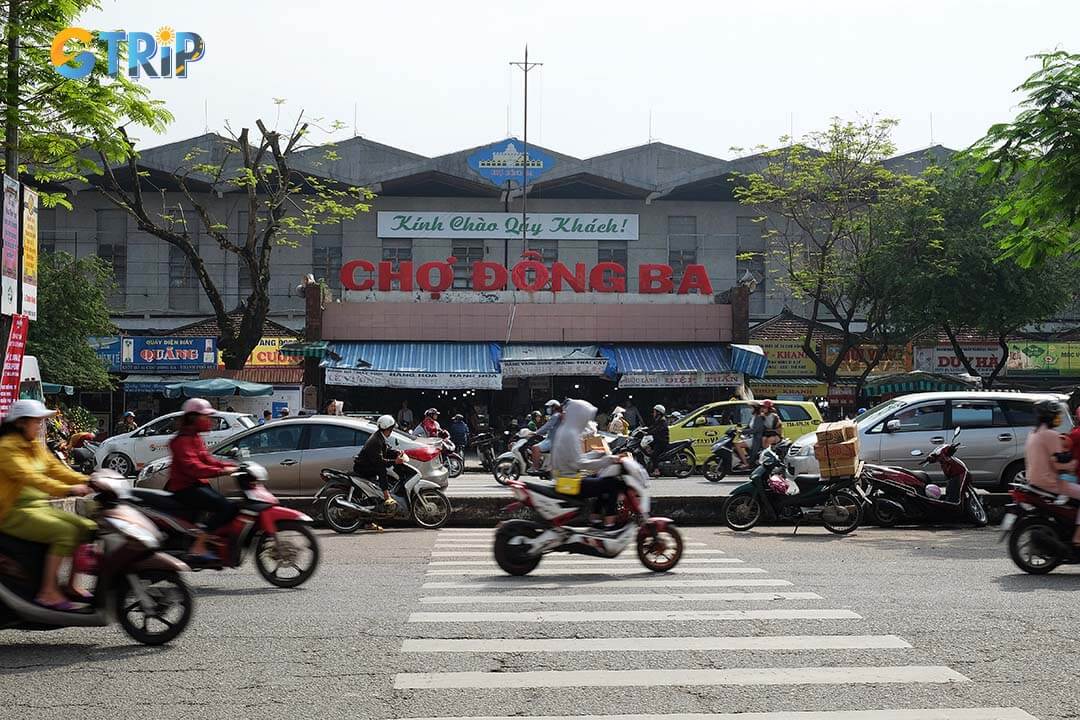
Dong Ba Market offers a vibrant mix of local culture, traditional cuisine, and handcrafted goods
FAQs when visiting Perfume River
Planning a trip to the Perfume River. If you're interested in a boat tour, independent exploration, here are answers to common questions to help you make the most of your experience.
1. How long does a typical Perfume River boat tour last?
A standard boat tour usually lasts between one to two hours, covering major attractions along the river. Longer tours may include visits to historical landmarks such as Thien Mu Pagoda and royal tombs, extending up to half a day. Private tours allow for more flexible itineraries, catering to specific interests like photography, history, or sunset viewing.
2. Is it possible to visit Perfume River without joining a tour?
Yes, exploring Perfume River independently is easy. You can rent bicycles to ride along the riverside, capturing scenic views and stopping at landmarks like Trang Tien Bridge and Ngu Binh Mountain. Alternatively, hiring a private boat directly from local operators provides a flexible and personalized experience.
3. What safety measures should I be aware of when SUP paddling on Perfume River?
When enjoying a Perfume River SUP paddling experience, wearing a life jacket is essential. Beginners should stay close to the riverbanks, while experienced you can explore further. Avoid paddling during heavy rain or strong currents, as conditions can become unsafe. Always inform someone of your route and expected return time.
Perfume River reflects Hue’s cultural legacy, with its historical legends, architectural landmarks, and vibrant festivals shaping the city’s identity. Exploring its tranquil waters through a Perfume River boat tour or a dragon boat ride offers a deeper connection to local traditions. Attractions like Thien Mu Pagoda and Hue Imperial City showcase architectural craftsmanship and historical significance. Seasonal events, from folklore song performances to boat races, capture Hue’s artistic spirit.
For the best experience, plan your visit during spring or autumn when the weather enhances scenic sunsets and outdoor activities. Whether enjoying a Perfume River sunset cruise or SUP paddling along its calm waters, the river promises moments of cultural immersion and natural beauty. If you're looking to explore more of Hue’s rich heritage, discover curated itineraries and guided experiences with Hue tours offered by GTrip - Vietnam Travel Agency, ensuring a comprehensive journey through the city’s historical and cultural landscapes.

